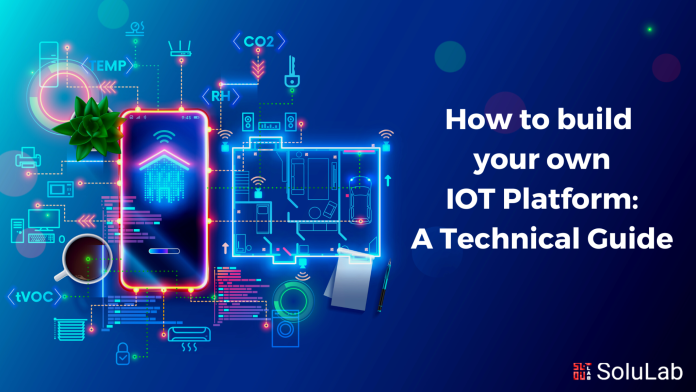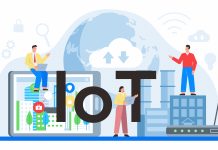If you research “IoT platform” on Google, you will get about 190 million results in less than a second. This is the amount of dissemination that IoT (particularly IoT platforms) has attained in recent years.
Whether you build a platform or buy one off the market, it makes a big difference. Furthermore, the term “Internet of Things platform” has multiple implications, and manufacturers have misused it to the point that it no longer conveys anything significant.
The IoT Development platform is the software that allows a company to monitor and, in certain cases, operate any device or IoT endpoint. Depending on the business model, it might be an on-premise suite or a cloud-hosted service with various features and services.
A conventional IoT development company is a middleware that offers all services and connections between hardware and applications that require hardware access. The details of the IoT platform will differ depending on the company model, but certain basic components are considered fundamental building blocks.
While there is no clear definition of IoT development, there is a widespread assumption that the platform will let high-level software, applications, and systems communicate with lower-level protocols, communication methods, and heterogeneous objects in general. This wide definition or understanding frequently implies that far too many items might fit within this criterion.
What Qualities Should a Great IoT Platform Have?
It makes far more sense to create your own IoT platform. Every middleware platform worthy of being a part of the Internet of Things must have the following features and characteristics.
The features of an IoT platform should have been determined by the client’s needs. A platform for a smart house will differ from one for a large-scale industrial organization. Yet, there are key fundamentals that every IoT development company must have:
Smart Connectivity
The most important element of an IoT platform should be a smart connection. The communication protocol is determined by the amount and frequency of data transferred. Smart connectivity comprises not only rapid data flow but also connection security.
Device Management
Device management is concerned with the provisioning and setup of devices so that data may be transmitted between them smoothly and securely. Bulk device action allows the platform to decrease manual labour and expenditures.
Scalability
The IoT development services should also be flexible to fulfil a growing organisation’s future demands. A company may need to add many devices to its network when it grows. This is only achievable if the IoT platform is both scalable and forward-thinking.
Real-Time Visibility
An IoT platform should provide real-time and historical data in an easy-to-understand graphical format. Visualisation will allow for problem appraisal and quick resolution.
When it comes to designing an IoT platform, low power consumption is critical. Such a platform assures that the gadgets can run for an extended period with long battery life.
Steps to build your own IOT Platform
It is vital to ensure that not only you know how to create it but also what you want to use it for. This ensures that IoT will benefit your business in a way that will not only repay your investment but also open the door to greater cost-efficiency of your current service, product, or production line. It might also improve your present goods and services by introducing new features and opportunities – and even generate new revenue.
Step 1: Thoroughly define your business goals
If you do not have the necessary expertise, you might seek the assistance of professionals, engineers, and experts. They can better assist you in determining if IoT demands an expenditure you can cover in the short term.
Define exactly what you want to do with the aid of IoT.
- You must determine and assert unequivocally:
- The problem you aim to solve;
- What do you intend to accomplish by addressing it
- What is the most effective solution?
It is likewise not recommended to begin with an “all-in” implementation. IoT may be adopted more gradually by limiting the amount of money available for process improvement each month or year.
Step 2: Investigate Tested IoT Use
Cases IoT is still relatively new, but it has existed long enough to be highly developed and established in several sectors. While the quantity and diversity of business IoT efforts are increasing, several compelling use cases already exist.
Step 3: Choose the Proper Hardware
When you decide to implement IoT development services , you must determine what will be involved. This entails determining each device or asset incorporated into the network. The data collected by the sensors must subsequently be transferred someplace over the internet.
This implies that another form of hardware is required: connecting devices that link the data-gathering sensor or other hardware to the IoT network. What you need to utilize is determined by your goals.
Step 4: Choosing IoT Tools
The internet is the foundation of IoT (so make sure you have a fast enough internet connection! ). Still, the IoT devices make it useful: they are always working for you, doing what you want them to do to improve the efficiency of your business’s processes.
An Internet of Things device is any device that can connect to an internet network to:
- Collect sensor data, analyze it, and deliver it across the Internet to the appropriate destinations.
- Accept commands through the Internet to operate actuators and perform a job, group of tasks,
- or do both.
Step 5: Choose an IoT Platform
An IoT platform is the software that controls and centralizes all aspects of the IoT network and its connected devices, including issuing commands and gathering data, typically through a cloud connection. It can be created in-house or purchased from a specialist provider.
Whichever method is used to get it, it is the cornerstone of the network. Thus, everything else must be constructed around it.
Conclusion
As you can see, the IoT is a multifaceted world full of complexities and perils, but it may also provide enormous benefits.
Always remember that if you plunge in without the necessary IOT Development services, it is far simpler to botch the implementation than it is to do it correctly. Every stage of the project presents new problems, from problem identification through complete implementation and ongoing investments, and each must be addressed, acknowledged, and resolved.
As a result, build a team of specialists and collaborate at every step of the process.
Author bio
An experienced writer, Hemal Sehgal. She has two years or more of expertise as a creative and experienced content writer. She is currently employed by a blockchain development firm in the USA, which has given her the opportunity to design original content strategies to convert website traffic into clients.






